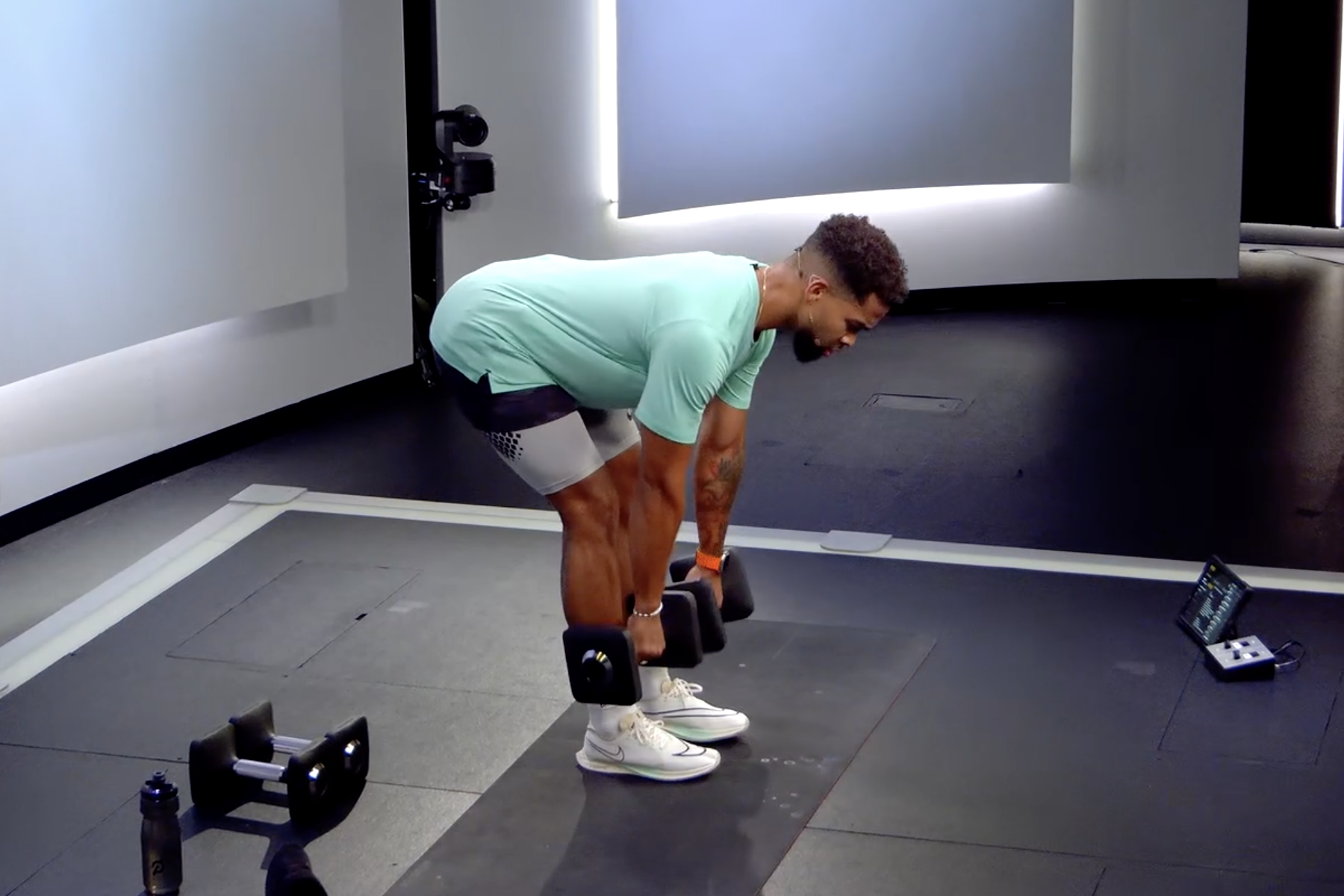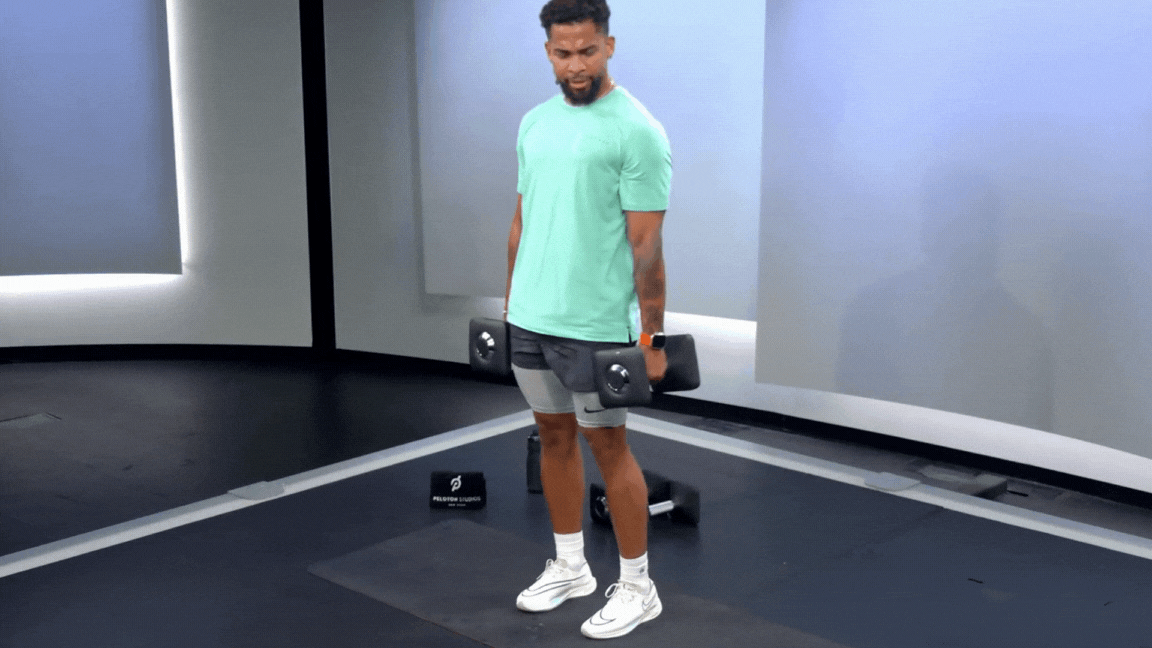
How to Do a Romanian Deadlift—the Ultimate Hamstring and Glute Strengthener
Here's what you need to know.
By Amber Sayer•
What Is a RDL?
What Muscles Does a RDL Work?
How to Do a RDL
RDL Variations and Alternatives
4 Common RDL Mistakes—and How to Fix Them
How Often Should You Do RDLs?
Who Should Avoid RDLs?
Regardless of whether you’re new to working out or a seasoned pro, lower-body strength exercises can feel, well, complicated. Do you focus on bodyweight movements? Grab some dumbbells? What about form? Or variations?
The deadlift and its counterpart, the Romanian deadlift (RDL), often inspire such angst. But they don't have to. Here, we asked Rad Lopez, a Peloton instructor, to break down everything you need to know about a RDL, including how to do it, common mistakes, and go-to variations.
What Is a RDL?
In a RDL, like in a traditional deadlift, you bend at your waist to lower added weight toward your ankles before standing back up, Rad says.
The secret to this exercise is focusing on your hips. “The movement pattern behind this exercise is a hip hinge, in which we hinge at the hips, slightly bend our knees, and tilt our upper body forward,” he says.
RDL vs. Deadlift
While RDLs and conventional deadlifts strengthen the same muscles, their movement patterns are a bit different, Rad says.
“The deadlift is more often than not performed by lifting the weights from the ground using a combination of leg drive, a deeper contraction, involvement of the hamstring, and hip drive,” Rad says. Most people typically opt to use a barbell (instead of dumbbells) in this exercise.
In a RDL, you use a truncated range of motion, extending the weights to the middle of your shin, instead of the ground.
What Muscles Does a RDL Work?
The RDL primarily strengthens your posterior chain muscles, including your lower back, glutes, hamstrings, and calves. Secondary muscles strengthened by RDLs include your core muscles, adductors (inner thigh muscles), traps, and posterior deltoids. Due to the engagement of your abdominal and back muscles to brace your spine throughout this movement, Rad notes that the RDL also helps improve your functional core strength.
What Are the Benefits of RDLs?
Your workout is more than just a sweat session. Certain movements, including RDLs, can also help make everyday activities a bit easier.
“The benefit of the RDL exercise is that it helps strengthen all the muscles in your posterior chain, which in turn, allows us to maintain a structurally sound posture,” Rad says. “By successfully training these muscles, you're going to make sure that you can complete and perform everyday tasks, such as walking, running, lifting heavy objects, bending over, and even playing with your kids and pets.” It’ll also prevent lower back injuries, he adds.
How to Do a RDL

When doing this movement, make sure to operate with control, Rad says. Move slowly and carefully.
Here’s how to do it:
Stand upright with good posture. Hold a heavy dumbbell in each hand. Place your arms in front of your thighs. Keep your chest lifted. Engage your core and glutes.
Hinge at your hips. Push your glutes behind you, allowing for a slight bend in your knees. Keep your core tight and your chest up. Your back should stay straight throughout this movement.
Lower the weights toward your shins. Straighten your arms and allow the weights to track down your legs. Pause briefly when the weights reach the midpoint of your shins.
On an exhale, drive through your heels and hinge from your hips. Use your glutes and hamstrings to stand back up to the starting position. Avoid rounding your back.
Pause at the top position. Squeeze your glutes.
Repeat for the desired number of reps.
Do You Squeeze Your Glutes in a RDL?
In short, yes. Make sure you're continuously engaging your glutes during this exercise. By doing so, you’ll reduce the risk of straining your hamstrings or lower back muscles by placing too much stress on those smaller muscle groups.
To fully engage your glutes in a RDL, think about squeezing them as if you’re trying to hold a penny between your butt cheeks when you press back up to the standing position. Continue to squeeze your glutes when you return to the starting position before beginning the next rep. This will help build your mind-muscle connection.
RDL Variations and Alternatives
You don’t need a barbell in order to work your lower body effectively. Doing RDLs with dumbbells is a great starting point for this type of exercise, Rad says.
“Holding a dumbbell in each hand allows for a more natural grip and reduces the need for balance, compared to a barbell,” Rad says. “This variation helps beginners focus on the hip hinge movement pattern and strengthens the posterior chain muscles.” It also forces you to prioritize your form. As you progress, you can opt for heavier weights or a barbell, he adds.
To make RDLs more challenging, practice a variation, such as a kickback deadlift or a single-leg deadlift. You can also do it as a bodyweight exercise—sans weights—to focus on mastering the hip hinge movement pattern.
If you’re looking for a way to work up to a RDL, start with beginner-friendly exercises that target the same muscle groups, such as a glute bridge. Here’s how to do it:
Lie on your back with your knees bent and your feet flat on the floor. Cross your arms over your chest or place your palms on the floor on either side of you.
Squeeze your glutes. Press through your heels to lift your butt in the air. You should create a straight diagonal line from your knees to your shoulders.
Pause at the top for a moment. Slowly lower back down.
Repeat for 10 to 20 reps.
4 Common RDL Mistakes—and How to Fix Them
Form is everything when it comes to doing a RDL. “We want to make sure that we keep a nice neutral spine throughout the entire move and stop our upper body when it's parallel with the ground on the hinge,” Rad says. “As far as foot placement, we want to make sure that our feet are directly beneath our hips.”
Here are a few common RDL mistakes and how to correct them:
1. Improper Foot Placement
In addition to ensuring that your feet are directly below your hips, position them at least hip-width apart. Keep your toes pointing forward. Make sure to distribute your weight evenly between both feet.
2. Rounding the Spine
Avoid rounding your back throughout this exercise. Imagine your back is a plank, and you need to tilt the entire plank as you move, instead of curving your spine. To achieve this, allow for a slight bend in your knees and sit your hips back as if you’re performing a partial squat.
3. Using Gravity and Momentum
RDLs should be done slowly and carefully. Make sure you’re selecting the proper weight for your fitness level to avoid relying on momentum as you hinge forward and lift up.
4. Not Using Your Core
Engage your core muscles throughout the movement. By bracing your abs, you’ll help protect your spine, improve your balance and stability, and reduce your risk of injury.
How Often Should You Do RDLs?
The number of reps and sets you do depends on your fitness level and goals. However, Rad says you typically want to focus on lifting heavier weights for fewer reps.
Remember that your muscles need time to recover between hard training sessions. Avoid doing this exercise on back-to-back days. Your lower body will thank you.
Who Should Avoid RDLs?
If you have any back or spine issues, Rad recommends avoiding this move. “This exercise puts significant stress on the lower back and spinal erector muscles,” he says. “It’s also best to avoid RDLs if you are experiencing acute injuries or pain, or even inflammation in the hips, hamstrings, or lower back.”